Buenos Aires, Argentina
Buenos Aires is the capital of Argentina and one of the 20 largest cities of the world. Its streets are still filled with a crumbling grandeur of early 20th century, the era most Lithuanians immigrated to Argentina.
Among those old buildings stand two Lithuanian centers, a Lithuanian church and small museum, five streets named after Lithuania. As everything had been created in 1930s-1970s, it also has a grand history.
Some 30 000 Lithuanians have immigrated to Argentina during a very short period in the middle of the interwar period (1925-1930). At that time, Argentina was possibly the second-richest country of the Americas (after the USA) and, unlike the USA at the time, it did not limit immigration.
Afterward, Argentina slowly became comparatively poorer and poorer. Now it is significantly poorer than Lithuania itself. Thus Lithuanians have long stopped migrating there and the current Lithuanians of Buenos Aires are nearly all descendants of the pre-WW2 migrants.

Lithuanian Center of Buenos Aires with a patriotic Columns of Gediminas symbol on the facade
Buenos Aires Lithuanian Center
Art-deco-inspired Lithuanian Center of Argentina (Centro Lituano) at Tabaré 6950 1439, Villa Lugano neighborhood, may be one of the most impressive Lithuanian secular buildings in South America.
Its façade is marked with Columns of Gediminas (a Medieval Lithuanian symbol). Inside, it has two floors, with a bar on the first floor and a dance hall above, where the Lithuanian traditional dance troupes rehearse.
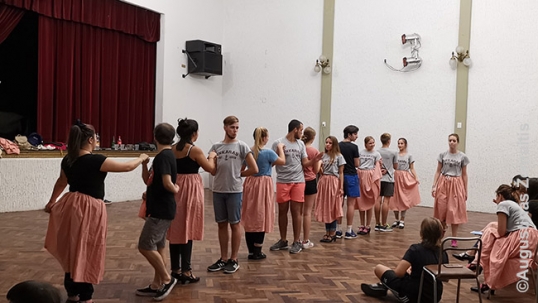
Lithuanian dancers at the Lithuanian Center
The interior is full of Lithuanian décor: the coats of arms of Lithuania and Lithuanian cities, artworks representing the Lithuanian national anthem and the Battle of Žalgiris (the largest battle where Lithuania participated, winning against the Teutonic Knights in the Medieval era). A nice symbolic artwork has been created by priest Antanas Lubickas (1981) while the coats of arms were created by Antanas Grigonis.
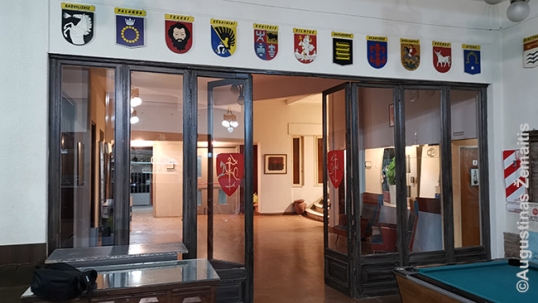
Grigonis’s coats of arms in the Lithuanian Center
The organization of Lithuanian Center of Argentina has been established in 1926 10 10. At the time, the largest wave of Lithuanian immigration to Argentina was commencing. The center was mostly established by intellectuals and the building itself was erected in 1957-1962, although the idea to erect it dates to 1920s when a Republic of Lithuania consul Jonas Skinkis created a "Lietuva" society. However, the plans to build the Lithuanian Center were precluded by the Great Depression (~1929) that had hit Argentina hard. While the plans were rejuvenated ~1934, they went on slowly in the 1930s and 1940s.
The building is officially named after Jonas Basanavičius, considered to be the patriarch of the Republic of Lithuania.
In 2014, a bas-relief to commemorate Lithuania has been created in the yard of the center. It incorporates many elements of Lithuanian history and culture, including its coat of arms, the famous castle of Trakai, the traditional wooden image of worried Jesus that tends to adorn Lithuanian roadsides (Rūpintojėlis), Hill of Corsses at Šiauliai, a couple dancing Lithuanian folk dances, etc.
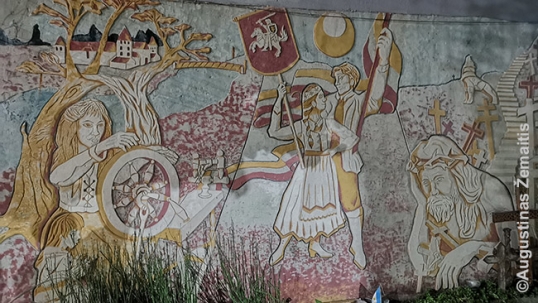
Bas-relief of the Lithuanian center
Lithuanian Center is open on Saturdays when dances and other events are held. At other days of the week, the premises are rented out, allowing it to operate.
Our Lady of Vilnius church complex
Many of the Buenos Aires Lithuanians settled in the Avellaneda suburb. There they have opened an Our Lady of Vilnius parish in 1942. It is better known as Our Lady of Mercy as the Spanish name now omits references to Vilnius. Still, right over the church entrance, there is an image of the Gate of Dawn in Vilnius, the city gate famous for the miraculous Virgin Mary image (Our Lady of Vilnius) that adorns it and that inspired the naming of the church. One of the side altars is also dedicated to this image.
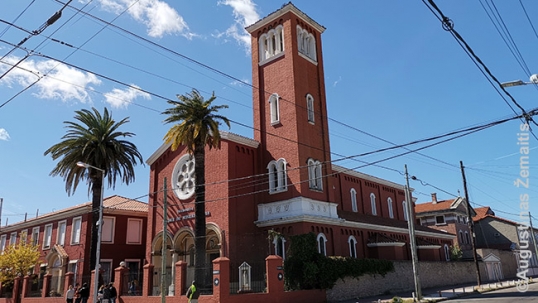
Buenos Aires Lithuanian church
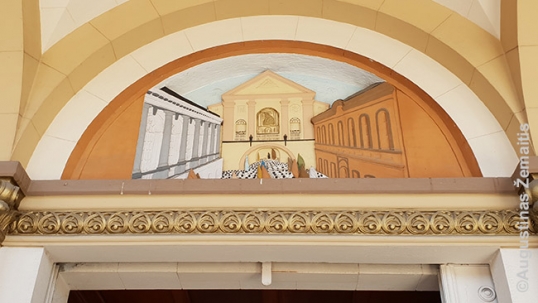
Gate of Dawn image over the Buenos Aires Lithuanian church entrance
Under each of the stained glass windows, a name and surname of the Lithuanian who helped to fund it are inscribed. Under some stained glass windows US cities are mentioned as well – as the Lithuanian-Argentine community was not as rich as the Lithuanian-American community, the church also received many donations from the USA Lithuanians.
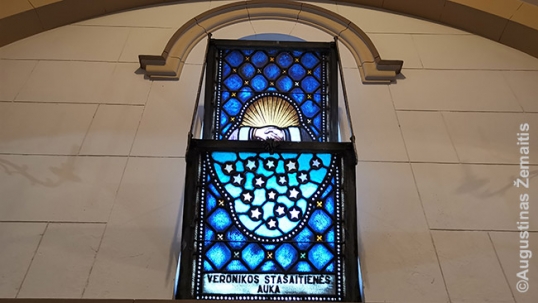
One of the stained glass windows of the Lithuanian church with a donor’s name
Currently, the Mass in the church is Spanish-only but the Lithuanian flag still stands inside.

The interior of the Lithuanian church with the image of Our Lady of Vilnius (another one is behind the altar)
Together with the church a Lithuanian Marian Fathers monastery and school were built (1948). Both buildings are still operating although they are no longer Lithuanian. The complex is still cared for by Marian fathers – however, now these fathers are Argentinians whereas the Lithuanian Marian fathers now operate in Lithuania alone. Still, the Marian order would not exist today if not for Lithuanians. At one time, Lithuanian Jurgis Matulaitis was the only remaining active Marian and it was through his charisma that the Marian order expanded once again, attracting Lithuanians, Poles, and now Americans, Argentines as well. For this reason, Jurgis Matulaitis is depicted on one of the church’s stained glass windows. The church also has St. Casimir (Lithuania’s patron saint) and Divine Mercy (a Christian cult centered around a painting that is in Vilnius, Lithuania) altars.
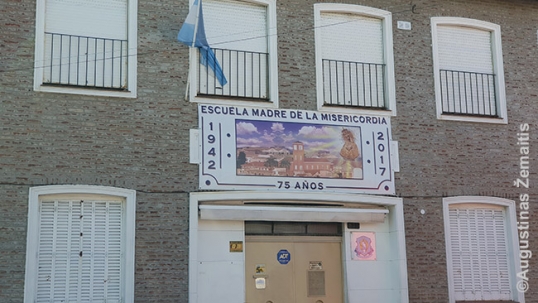
Lithuanian parish school of Buenos Aires
Lithuanian school building does not have many Lithuanian details, however, Lithuanian religious symbols do exist (Jurgis Matulaitis, Our Lady of Vilnius painting) while the stadium outside is adorned with a cross painted in Lithuanian flag colors. The school is now attended by ~800 pupils, most of them not of Lithuanian ancestry. Initially, the school building (the event hall on the second floor) also served as a Lithuanian club.
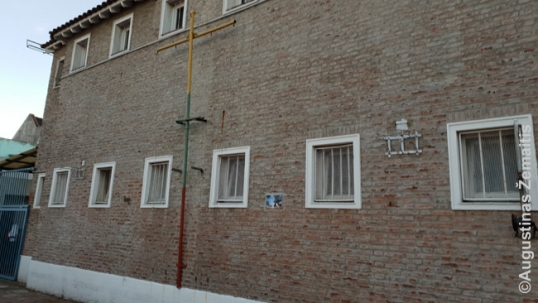
Cross painted in the colors of Lithuania’s flag in the stadium of Buenos Aires Lithuanian church
Lithuanian monastery also houses a Lithuanian museum which has no regular opening times (one should ask at the sacristy to be allowed inside although that is only possible when the museum’s hall does not double as a parish hall). The museum has been established in 1955 by A. Mikelionienė. Most of its exhibits are things collected by Lithuanian-Argentines that reminded them of the Homeland they left: traditional Lithuanian wooden crafts, ethnic strips, old Lithuanian books (some dating to the 19th century) and other things. At one time, the museum was larger and had over 1000 exhibits, including sculptures, folk costumes, etc. Later, however, the area was repurposed as a parish hall and thus fewer exhibits remained. Once, the building also housed the publishing house for “Argentinos lietuvių balsas” (the Voice of Lithuanian-Argentines), the major Lithuanian-Argentine newspaper. After it stopped publishing, the printing technics were moved to a Lithuanian museum in Esquel (Patagonia).
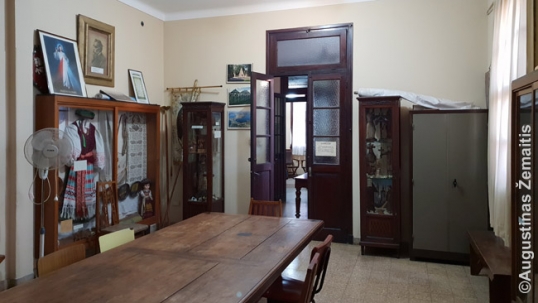
Lithuanian museum / parish hall (some half of the room is visible)
A cozy churchyard (closed from outside and accessible only through the sacristy) includes a traditional Lithuanian wooden cross (rebuilt in 2015) and Monument for those who died for Lithuania that incorporates Lithuanian Columns of Gediminas and Cross of Vytis symbols and Virgin Mary image (~1969). On the yard side, the church is adorned with memorial plaques for St. Cecilia Lithuanian choir that used to operate in the parish. Both monuments also have numerous Lithuanian memorial plaques.
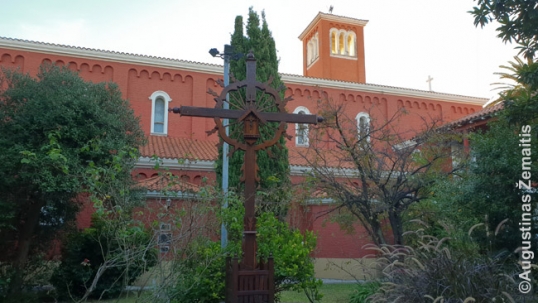
Lithuanian cross in the Our Lady of Vilnius church yard of Buenos Aires

Monument for those who died for Lithuanian freedom in the Our Lady of Vilnius church yard of Buenos Aires
Historically, the teachers of the Our Lady of Mercy school were Lithuanian nuns from the order of St. Casimir, established by Lithuanian-Americans. Sent to the Lithuanian-Argentine community in 1941, they also had their convent in Avellaneda but, as the numbers of the nuns declined, the convent was sold and the remaining nuns relocated to smaller premises.
The street in front of the church is named Lithuanian Alley (Pje Lituania). At its end where the passage is nearest to the church, there is a memorial plaque commemorating the fact that the street was named in honor of the Lithuanian community.

Comemorative plaque of the Lithuanian Alley of Avellaneda
Lithuanian Alliance in Argentina
Lithuanian Alliance of Argentina also has its hub in Buenos Aires (Av. San Martin 3175, Lanus Oeste district).
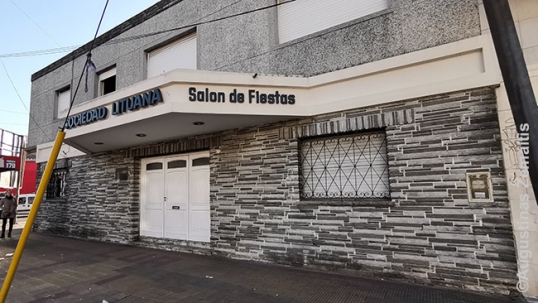
Lithuanian Alliance of Argentina
Externally the building may look simple but it hosts large premises inside. The building has been dedicated to Vincas Kudirka (the author of Lithuanian national anthem), therefore, at its heart lies a rather monumental stairway with a large Vincas Kudirka portrait above and balustrades with Columns of Gediminas symbols.
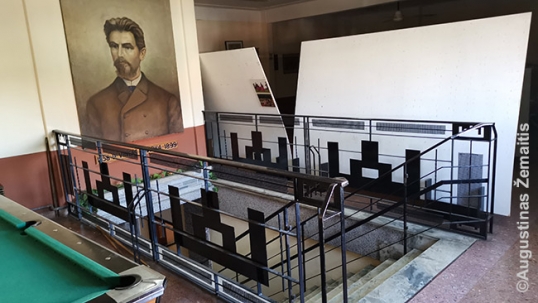
Staircase of the Lithuanian Alliance of Argentina
The second floor includes an interesting small exhibition of old materials representing Lithuania: interwar postcards, caricatures, postmarks and more. A large part of those are things that were used by interwar Lithuania to promote itself among foreigners. There is also some information on the occupation of Lithuania. The information is available in numerous languages – Lithuanian, English, German, Spanish (many of the inscriptions were originally in those languages). Browsing all that you may feel as if you’d be transported into some 1950, see the original texts and images Lithuania then used to introduce itself to the world with little-if-any new commentary. These were collected by Juozas Šiušis.
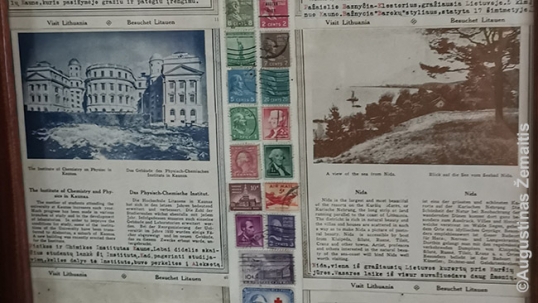
Lithuanian Alliance of Argentina gallery of interwar Lithuanian introductions to foreigners
The second floor of the Lithuanian Alliance of Argentina also hosts a library (according to locals, established by Juozas Pauga who smuggled Lithuanian books into Lithuania at the time they were banned by the occupying Russian Empire). There are also many commemorative plaques to commemorate various important events, such as presidential visits. As the Lithuanian Alliance of Argentina is a potent symbol of Lituanity in Argentina, it has been visited by more than a single Lithuanian president, among them Algirdas Brazauskas (1996) and Dalia Grybauskaitė.

Comemorative plaques in the Lithuanian Alliance of Argentina
The first floor of the Lithuanian Alliance of Argentina has an event hall, a pool, a bar, a Lithuanian yard named after its architect Alfredas Stanevičius.
Lithuanian Alliance of Argentina is the oldest Lithuanian organization of the greater Buenos Aires (excluding Beriso). It has been established in 1914, still a decade before the main wave of Lithuanian immigration. However, at that time there were just some 5000 Lithuanians in whole Argentina – not enough to own a separate building in Buenos Aires. Therefore, the Lithuanian Alliance of Argentina used to rent halls. However, as over 10000 new Lithuanians immigrated to Buenos Aires alone in years 1925-1929, the Lithuanian Alliance of Argentina quickly grew in ranks. After the new immigrants found jobs and gained steady income, Lithuanians collected enough money to buy own land lot (1941, a lot of 3779 square meters) and then construct their own building.
The building of the Lithuanian Alliance of Argentina has been opened in 1952 07 12 (on the occasion of the 38th anniversary of the organization). At the time, Lithuanians also owned the nearby land at the location of the current 25 de Mayo street. Later this land was nationalized by the city in order to build the street; in return, the city gave Lithuanians more land at the other side of the building (northwest), making the lot long.
In 1983, the building was expanded northwestwards by building a pool (architect Kaminskas). It used to be popular to spend time there in summer, however, as time passed, the pool has ceased operations.
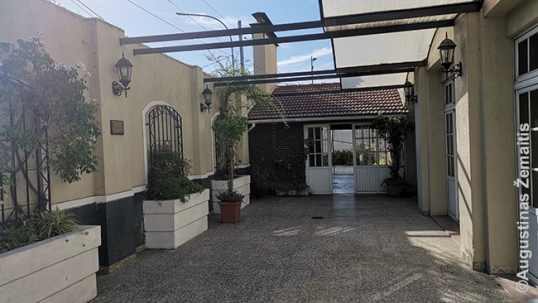
Stanevičius Lithuanian yard in Buenos Aires
Lithuanian Alliance of Argentina is open on Saturdays and willing accepts Lithuanian guests from elsewhere. In addition to regular Saturdays, there are some 5-10 annual larger festivals, among them the independence days of Lithuania (February 16th, March 11th), Mother’s day, also a now-traditional Beer festival in October. During the main festivals, some 200 people come to the Alliance (some 350 during the Beer festival). The organization has 400-500 members.
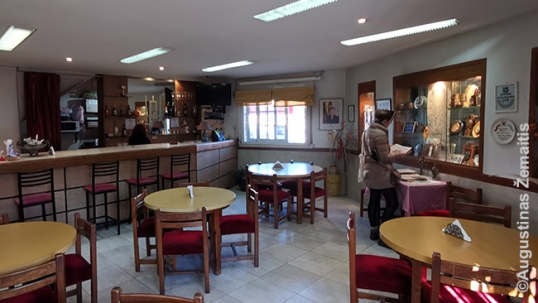
Lithuanian Alliance of Argentina bar
Not far away from the Lithuanian Alliance of Argentina, there is the longest one of the Buenos Aires area’s streets named after Lithuania - Lithuania Avenue (Avenida Lithuania).
Historically, since 1936, Lithuanian Alliance of Argentina had additional "sections" in other districts: 2nd section in Avellaneda (where the Lithuanian church is), 3rd in Lugano (where the Lithuanian Center is), 4th in Barracas, 5th in Villa Scasso, 6th in Cordoba, 7th in Wilde, and 8th in Temperley. Of these, all besides the one in Cordoba were located in greater Buenos Aires and lacked their own buildings. Eventually the sections withered and the Buenos Aires activities became concentrated in the Lithuanian Alliance building at Lanus where the 1st section used to be based.
Lanus district itself also had a Lithuanian school named after Tumas-Vaižgantas. It was established in 1938 by the Republic of Lithuania that sought to keep the Lithuanian spirit alive among its emigrant communities. However, soon afterwards, Lithuania was occupied by the Soviet Union (1938) and thus no teachers or money could come to the school from there. The school closed down, although the building still remains.
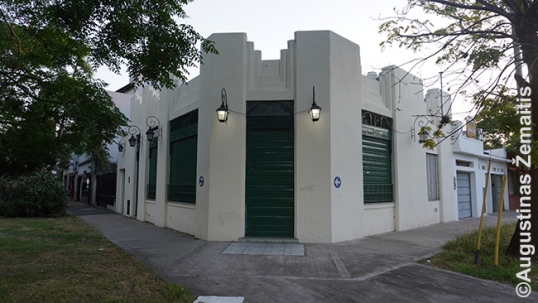
Tumas-Vaižgantas school building
Other Lithuanian sites of Buenos Aires
Buenos Aires (together with the surrounding suburbs) have more streets named after Lithuania than any other city. In addition to the two streets mentioned above (Lithuanian Avenue and Alley), there are also Lithuanian streets in Don Bosco, Temperley and Villa Urquiza neighborhoods. Only the last one of these districts is part of the official city of Buenos Aires – the remaining ones are considered suburbs. In general, in Buenos Aires, it is popular to name streets after various foreign places, especially those places where many immigrants to the city hail from.
Next to its port, Buenos Aires has a Museum of Immigration that operates in the same building where immigrants used to stay back in the interwar era after they had arrived from Europe. The immigrants used to stay there as long as they would find a job. Thousands of Lithuanians spent their first days in Argentina there as well. However, the exhibition of the museum (which also doubles as a museum of modern art) does not have anything particularly related to Lithuanians – yet, it is still possible to learn more about the Lithuanian migration to Argentina as the experience of different immigrant ethnic groups at the time used to be similar.
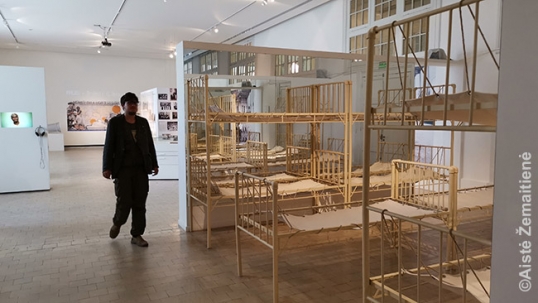
Recreated lines of bunks that used to be temporary homes for thousand s of Lithuanians in what is now the Buenos Aires museum of immigration
Argentina had some Lithuanian immigrants even before the main wave and arguably the most famous among those was Robertas Adolfas Chodasevičius (Roberto Adolfo Chodasewicz) who used a hot air balloon in the war in Argentina for the first time. He is buried in the same crypt as other veterans of the War of Triple Alliance in the famous Recoleta cemetery where Eva Peron is also buried. However, his name is not inscribed on that common grave but it may be seen in the electronic cemetery records system near the entrance, where the fact he had been born in Vilnius is also mentioned.
In 2002 Lithuania opened its embassy in Buenos Aires (relocated from Caracas, Venezuela), which served as sole Lithuania’s embassy in entire South America. It used to organize various cultural activities and, according to the local Lithuanians, it had reignited Lithuanity. However, in 2013, the embassy has been closed down as a cost-saving measure and replaced by a consulate-general in Sao Paulo (Brazil).
The Buenos Aires suburb of Bernal once had the third Lithuanian club of the Buenos Aires area, named Circulo Lituano. By far, it was the most controversial one, as it was communist. With Lithuania occupied by the Soviet Union since 1940 and 1944, and Soviet Union performing a genocide in Lithuania, communism became as hated among most Lithuanians of the time as Nazism is hated by Jews. Thus, "Circulo Lituano" was effectively isolated from other Lithuanian-Argentine organisations (and it did not seek such cooperation either). Except for the name, it felt as "Circulo Lituano" represented a different nation than did all the other Lithuanian-Argentine organisations, as it used the Soviet-imposed symbols of Lithuania rather than the ones of 1918-1940 independent Lithuania. To Circulo Lituano members, Soviet-occupied Lithuania was still Lithuania (perhaps even the "ultimate Lithuania"), while most of Lithuanian Argentines saw the period as temporary hell when Lithuania was not free. Spectacularly, "Circulo Lituano" had outlasted the Soviet Union by far but ~2010, some 20 years after Lithuania restored its independence, it closed down for good. The residential-house-looking building that once housed Circulo Lituano became a house for seniors.
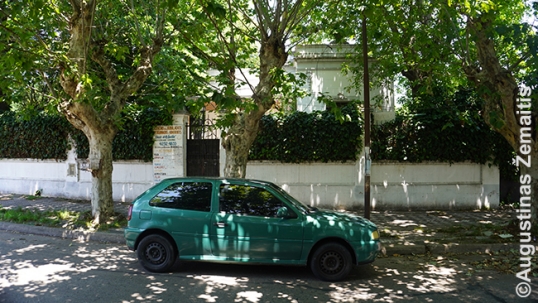
Circulo Lituano building in Bernal
The "holiest place of Argentina" Lujan basilica near Buenos Aires since 1998 has converted its cellar into a shrine where the famous Virgin Mary images from various countries are represented. Among those images is that of Our Lady of Vilnius from Lithuania - its copy, Lithuaian flag, and short history are presented. The cellar may be accessed with tours.

Our Lady of Vilnius in Lujan Basilica cellar
To the north of Buenos Aires lies the unique massive area of Rio Parana Delta. There, many villages and farmsteads could be accessed only by boat. The area was both popular among some Buenos Aires Lithuanians to acquire lands for farming and also for recreating. A hub for such recreatin was Hotel Lietuva near Villa Paranacito. It was created by Nalivaika family. Nailivaika himself had been sent by Lithuania as a teacher in Tumas-Vaižgantas Lithuanian school but after Lithuania was occupied had nowhere to return to and moved to live in the islands. His hotel served as a hub of Lithuanian activities, although Lithuanians needed to spend 4 hours to arrive there from Buenos Aires by boat. Currently Hotel Lietuva is no longer in operation, but the building still stands with Lithuanian symbols and inscriptions remaining on the facade. The hotel is near Villa Paranacito but may only be accessed by boat from that town.

Facade of Hotel Lietuva
There are more Lithuanian places in the cities of Rosario and Berisso that are near Buenos Aires. They are, however, described in separate articles.




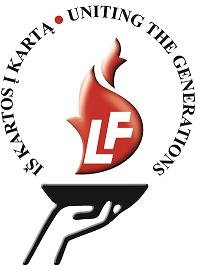

May 9th, 2019 - 12:27
Muziejuje yra ir vien tik lietuviškų dokumentų, ypač susijusių su litvakais, tačiau gali būti, kad jie ne visuomet eksponuojami 🙂
May 9th, 2019 - 15:19
Kalbate apie Lietuvių muziejų prie Buenos Airių lietuvių bažnyčios?
May 15th, 2019 - 12:42
apie Imigracijos muziejų, nes rašėte, kad “nėra nieko susijusio išskirtinai su Lietuva” 🙂
May 15th, 2019 - 17:02
Taip, gali būti, kad ne visada eksponuojami, ekspozicija mums lankantis buvo gana nedidelė, didžioji jos dalis skirta meno kūriniams tik menkai susijusiems su imigracija, dar kažkiek šiuolaikinei nelegalios migracijos problemai, ir tik koks trečdalis istorinei imigracijai į Argentiną, ten daugiausiai – statistika ir nuotraukos. Taip pat yra atskiros ekspozicijos kai kurioms daugiausiai imigrantų davusioms tautoms, bet tarp jų nėra lietuvių.
Iš esmės “Gabalėliai Lietuvos” koncentruojamės į tai, ką gali pamatyti kiekvienas bet kuriuo metu, daugiausiai – nekilnojamąjį paveldą, o taip pat nuolatines muziejų ekspozicijas, nuolat bažnyčiose kabantį meną ir pan. Tai, kas paprastai yra archyvuose, arba kas yra privačiose patalpose į kurias įleidžiamas ne kiekvienas norintis, kas sudaro laikinas parodas ar laikinus renginius, yra už “Gabalėlių Lietuvos” ribų (nebent, tarkime, tam tikra laikina paroda ar renginys vyktų kasmet, kas mėnesį ar kitokiu prognozuojamu reguliarumu).
November 23rd, 2021 - 05:06
Fantastic article and photos! Thanks very much!